
PREV ARTICLE
NEXT ARTICLE
FULL ISSUE
PREV FULL ISSUE
NUMISMAGRAM MEDAL SELECTIONS: JUNE 2020Jeremy Bostwick at Numismagram is back with some more great art medals and plaques, offering 30 different items for June—much more than his usual upload. -Editor Jeremy adds: "This increase in interesting pieces for the month reflects a corresponding increase in buying of late, so stay tuned if you have been seeking museum quality exonumia while the attending of shows remains virtually impossible. In addition to the items below, there are some great Napoleonic-era, Art Deco, and WWI-related pieces, as well as some alluringly engraved coin art. Please visit numismagram.com/inventory for all of these new additions."
Radio Art Deco Medal 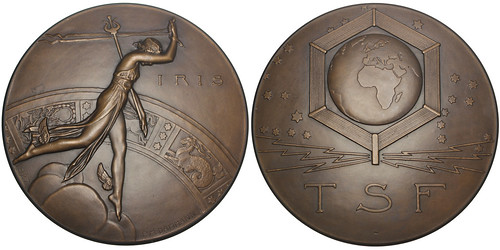
101128 | FRANCE. Télégraphie sans Fil [Radio] Art Deco bronze Medal. Issued 1927. The emergence of wireless or radio communication (99mm, 12h). By P. Dammann in Paris. IRIS, Iris striding right among the clouds, head lowered, holding trident-headed scepter and streamers; in background, zodiacal band with Scorpio, Sagittarius, and Capricorn / View of the Earth, focused upon Europe and Africa, surrounded by hexagonal, segmented antennae, the bottom segment of which is emitting radio waves; stars in the background, T S F [Télégraphie sans Fil = telegraph without wires] below. Edge: «cornucopia» MONETA 28. Jones, Art of the Medal, 423. Gem Mint State. Alluring bronze-brown surfaces, with a light matte nature. Likely one of the finest known of this small output in the larger (99mm) module, of which this is numbered (on the edge) as #28. One of the iconic and rarer Art Deco medallic works of the period. $895 Following the proof of the existence of electromagnetic waves by German physicist Heinrich Hertz in 1887, a flurry of other scientific minds turned to a new medium for study—the "airwaves." Guglielmo Marconi's invention of the radio, for which he won the 1909 Nobel Prize in Physics, furthered what would become a rapidly growing industry during the first three decades of the 20th century, as communication now need not be reliant upon the connection of wires. Here, Dammann captures this novel technology and pairs it with another movement indicative of its era—the refined, elegant, and geometric artistry that embodies Art Deco. Gotta love it. A great Art Deco design. -Editor
To read the complete item description, see:
Charles Darwin Medal 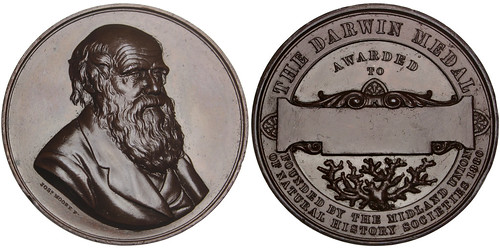
101150 | GREAT BRITAIN. Charles Darwin bronze Medal. Issued 1880 or later by the Midland Union of Natural History Societies for the Darwin Prize [unawarded] (44mm, 39.11 g, 12h). By J. Moore in Birmingham. Bust facing slightly right / THE DARWIN MEDAL / AWARDED TO / FOUNDED BY THE MIDLAND UNION OF NATURAL HISTORY SOCIETIES 1880, elaborate scroll left blank for engraving; branch of coral below. Edge: Plain. Choice Mint State. Rich red-brown surfaces, with a great deal of brilliance; a few subtle rim bruises are noted merely for completeness. Very rare and interesting. Compare to a slightly different Darwin medal contemporaneous with this one, struck for the Royal Society, which just realized a total of €1,020 (after the buyer's fee) in late May. $795 Very little can be located relating to the history of this medal as well as the number of specimens issued during the late 19th century, and they are missing from any public sales from the past two decades. An article from the 9 July 1887 issue of The Gardeners' Chronicle (p. 51) reveals a brief history of the medal and its recipients up to that point: "THE DARWIN MEDAL—At the annual meeting of the Midland Union of Natural History Societies, held on Wednesday, July 6, at Malvern, the Darwin Medal, which is this year set apart for Archæology, was awarded to Mr. Edward W. Badger, M.A., of King Edward's High School, Birmingham, for his paper on "The Monumental Brasses of Warwickshire." The adjudicators were the Very Rev. J. J. Stewart Perowne, D.D., Dean of Peterborough; M. H. Bloxham, Esq.; John Amphlett, Esq.; W. H. Duignan, Esq.; and J. A. Cossins, Esq. The adjudicators' report speaks in high terms of the value and interest of the paper, and comments upon the care and ability evidenced in its preparation. The Darwin Medal was founded in 1880 by the Midland Union of Natural History and other scientific societies for the purpose of encouraging original research by members of the societies forming the Union. The scheme was submitted to Mr. Charles Darwin, and received his cordial approval. With his permission the prize was named after him. The subjects for which the Medal is awarded are geology, archæology, zoology, and botany. It has been previously gained four times—in 1881, by Mr. Edward Wilson, F.G.S., for geological research; in 1882, by Professor A. M. Marshall, D.Sc. (of Owen's College), and Mr. W. P. Marshall, M.I.C.E., for their investigations into the life-history of the "Pennatulida;" in 1884, by Mr. W. B. Grove, B.A., for a monograph on the "Pilobolidæ," and other botanical papers; and in 1885, by Mr. W. J. Harrison, F.G.S., for geological research. It was not awarded in 1883 or in 1886. The medal is a handsome one, the dies for which were engraved by Mr. Joseph Moore, of Birmingham. On the obverse is a finely executed bas-relief bust of Charles Darwin, and on the other a branch of coral, commemorative of an important research made by the great naturalist. This is the first time the Medal has been awarded to an archaeologist." The giants of science don't come much bigger than Darwin. Great medal. -Editor
To read the complete item description, see:
Sellafield and Chernobyl Medal. 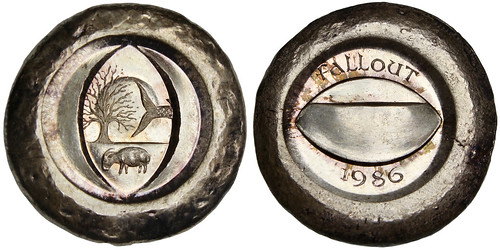
101145 | GREAT BRITAIN & UKRAINE. Sellafield and Chernobyl cast silver Medal. Issued 1986. Fallout (29mm, 25.97 g, 3h). By M. Appleby. Representations of flora and fauna (tree, fish, and goat) affected by the impact of nuclear fallout and other airborne environmental disasters; all within vertical 'cat eye' border / FALLOUT / 1986 around horizontal 'cat eye' border. Edge: «4 hallmarks». BAMS 37, M10. Gem Mint State. Essentially as issued, with a pleasing prooflike nature, great luster, and some subtle toning. A powerful and rare piece, 1 of just 39 cast by the artist from hand engraved dies. $345 Produced in the aftermath of the Chernobyl disaster—a nuclear accident in the spring of 1986 near the city of Pripyat in Soviet Ukraine—this moving medal alludes to the impact of the radioactive fallout that touches aspects of life, be it flora or fauna. Due to wind patterns, areas in Northern Europe (like the artist's home country of Scotland) began to see an impact, with particles of caesium-137—a radioactive isotope that is a common product following a fission reaction of the primary "fuel," uranium-235—being scattered across the countryside. Likewise, the much closer Sellafield nuclear power plant, located in northern England near the border with Scotland, has had its own problematic history with contamination. This medal serves as a reminder of the shared experiences of everyone on the planet, and that what can affect one can affect everyone and everything. Interesting and unusual piece - I hadn't seen this one before. -Editor
To read the complete item description, see:
Jacques-Arsène d'Arsonval Medal 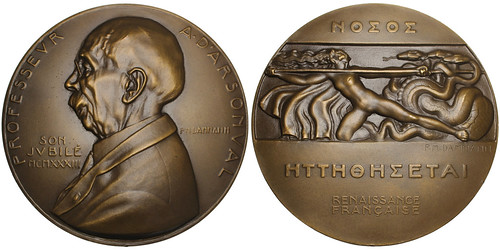
101143 | FRANCE. Jacques-Arsène d'Arsonval bronze Medal. Issued 1933. La maladie sera vaincue (80mm, 238.30 g, 12h). By P. Dammann at Arthus-Bertrand in Paris. PROFESSEVR A D'ARSONVAL / SON JVBILÉ MCMXXXIII, bust left / ??S?S ????T?S???? (the disease shall be overcome), in bas relief, nude female on knees, wearing cape and spearing three-headed serpentine hydra to right; RENAISSANCE FRANÇAISE. Edge: «triangle» BRONZE. Maier –. Gem Mint State. Olive-bronze surfaces, with an alluring matte nature. A great Art Deco design by one of the masters. $375 The inventor of his eponymous galvanometer, Jacques-Arsène d'Arsonval was a famous French physician and physicist who contributed greatly to the field of electrophysiology—the science that investigated the effects of electricity on organisms. The reverse of this medal alludes to the conflict between disease and the science to combat it. I like this great Art Deco design. -Editor
To read the complete item description, see:
Napoléon I Medal 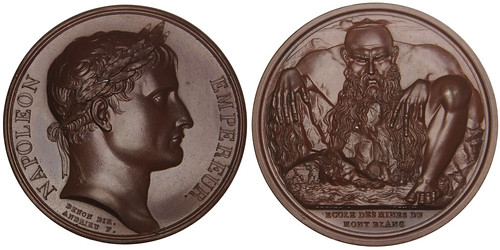
101171 | FRANCE. Napoléon I bronze Medal. Issued 1804. The establishment of the School of Mineralogy at Mont Blanc (39mm, 42.21 g, 12h). By B. Andrieu and N. G. A. Brenet in Paris. NAPOLEON EMPEREUR, laureate head right / Mont Blanc (as an old man of colossal size), crouching facing and lifting large rock under which two miners are working; in two lines in exergue, ECOLE DES MINES DU / MONT BLANC. Edge: Plain. Bramsen 471; Julius 1498; d'Essling 1121; Zeitz 34. Gem Mint State. Rich red-brown surfaces, with a great deal of brilliance remaining. Popular allegorical type. $495 One of the iconic types within the celebrated Neoclassical Napoleonic series, this medal features an expressive and intricate anthropomorphization of the mountain, presenting it as an old man, balding and with a rather robust, unkempt beard. As one travels down further from his face, the beard transforms into a waterfall in which fish swim. Under his right hand, two miners are at work—one hacks at the earth with an axe, while the other pushes a minecart. Creepy and unusual design. -Editor
To read the complete item description, see:
Samuel Thomas Sömmering Medal 
101109 | GERMANY Samuel Thomas Sömmering bronze Medal. Issued 1827. Commemorating the 50th anniversary of his doctorate (50mm, 77.50 g, 12h). By C. Pfeuffer & G. Loos in Berlin. S TH A SOEMMERRING NAT THORUNI D XXVIII IAN MDCCLV DOCT CREAT GOTTINGAE D VII APR MDCCLXXVIII, bare head right; serpent-entwined staff to right / ANATOMICORUM PRINCIPI ANIMAE ORGANA QUI APERUIT ARTIS VIRIQUE CULTORES D VII APR MDCCCXXVIII, view of a human brain from the top. Edge: Some staining, otherwise plain. Brettauer 1159; Sommer P-19; Joseph & Fellner 1030. Choice About Uncirculated. Reddish-brown surfaces, with some underlying brilliance in the fields; some scattered spots are noted throughout. Highly interesting anatomical type. $265 One of the most important German anatomists, Samuel Thomas Sömmering received his doctorate from the University of Göttingen in 1778, for which he described the organization of the cranial nerves. During his career, he investigated the brain and nervous system, as well as sensory organs and the lungs. Of particular note, he discovered the macula in the retina of the human eye. Given this intense focus on the nervous system as a whole, the choice of a human brain on this doctorate celebratory medal is quite appropriate. The brainiest medal I've ever seen! -Editor
To read the complete item description, see:
Wayne Homren, Editor The Numismatic Bibliomania Society is a non-profit organization promoting numismatic literature. See our web site at coinbooks.org. To submit items for publication in The E-Sylum, write to the Editor at this address: whomren@gmail.com To subscribe go to: https://my.binhost.com/lists/listinfo/esylum All Rights Reserved. NBS Home Page Contact the NBS webmaster 
|